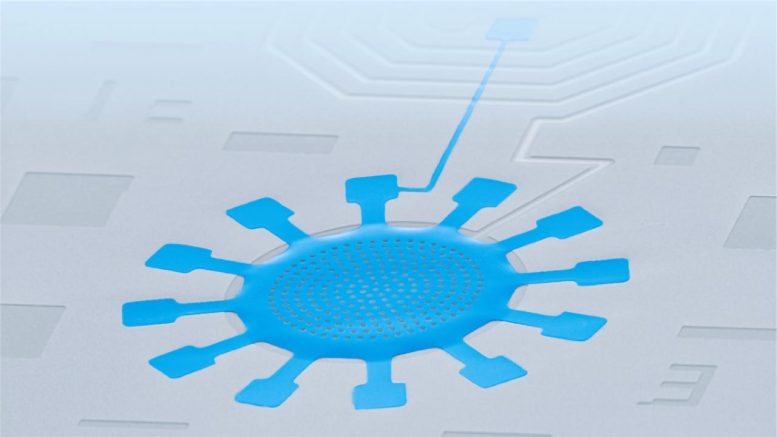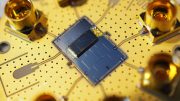
Scanning electron microscope image of an ultra-coherent superconducting electro-mechanical system. Credit: Amir Youssefi (EPFL)
Scientists at EPFL have developed a superconducting circuit optomechanical platform that demonstrates ultra-low quantum decoherence and high-fidelity quantum control. Their groundbreaking work with a “vacuum-gap drumhead capacitor” has led to the longest quantum state lifetime in a mechanical oscillator ever achieved, paving the way for new applications in quantum computing and sensing.
Over the past decade, scientists have made tremendous progress in generating quantum phenomena in mechanical systems. What seemed impossible only fifteen years ago has now become a reality, as researchers successfully create quantum states in macroscopic mechanical objects.
By coupling these mechanical oscillators to light photons — known as “optomechanical systems” — scientists have been able to cool them down to their lowest energy level close to the quantum limit. They have also managed to “squeeze them” to reduce their vibrations even further, and entangle them with each other. These advancements have opened up new opportunities in quantum sensing, compact storage in quantum computing, fundamental tests of quantum gravity, and even the search for dark matter.
The Dilemma of Operating Optomechanical Systems
In order to efficiently operate optomechanical systems in the quantum regime, scientists face a dilemma. On one hand, the mechanical oscillators must be properly isolated from their environment to minimize energy loss; on the other hand, they must be well-coupled to other physical systems such as electromagnetic resonators to control them.
Striking this balance requires maximizing the oscillators’ quantum state lifetime that is impacted by their environment’s thermal fluctuations and oscillators frequency instabilities – what is known in the field as “decoherence.” This is a persistent challenge across various systems, from the gigantic mirrors used in gravitational wave detectors to tiny trapped particles in high vacuum. Compared to other technologies like superconducting qubits or ion traps, today’s opto- and electro-mechanical systems still show higher decoherence rates.
Breakthrough at EPFL: Ultra-Low Quantum Decoherence
Now, scientists at the laboratory of Tobias J. Kippenberg at EPFL have tackled the problem by developing a superconducting circuit optomechanical platform that shows ultra-low quantum decoherence while maintaining large optomechanical coupling that results in a high-fidelity quantum control. The work was published on August 10 in the journal Nature Physics.
“In simple words, we demonstrated the longest quantum state lifetime ever achieved in a mechanical oscillator, which can be used as a quantum storage component in quantum computing and communication systems,” says Amir Youssefi, a PhD student who led the project. “This is a big achievement and impacts a wide range of audiences in quantum physics, electrical engineering, and mechanical engineering.”
The Key Element: Vacuum-Gap Drumhead Capacitor
The key element of the breakthrough is a “vacuum-gap drumhead capacitor,” a vibrating element made of a thin aluminum film suspended over a trench in a silicon substrate. The capacitor serves as the vibrating component of the oscillator and also forms a resonant microwave circuit.
Through a novel nanofabrication technique, the team significantly reduced mechanical losses in the drumhead resonator, achieving an unprecedented thermal decoherence rate of only 20 Hz, equivalent to a quantum state lifetime of 7.7 milliseconds – the longest ever achieved in a mechanical oscillator.
Results and Implications
The remarkable decrease in thermally induced decoherence allowed the researchers to use optomechanical cooling technique, resulting in an impressive 93% fidelity of the quantum state occupation in the ground state. Additionally, the team achieved mechanical squeezing below the zero-point-fluctuation of motion, with a value of -2.7 dB.
“This level of control allows us to observe the free evolution of mechanical squeezed states preserving its quantum behavior for an extended period of 2 milliseconds, thanks to the exceptionally low pure dephasing rate of only 0.09 Hz in the mechanical oscillator,” says Shingo Kono, who contributed to the research.
“Such ultra-low quantum decoherence not only increases the fidelity of quantum control and measurement of macroscopic mechanical systems, but will equally benefit interfacing with superconducting qubits and places the system in a parameter regime suitable for tests of quantum gravity,” says Mahdi Chegnizadeh, another member of the research team “The considerably longer storage time compared to superconducting qubits makes the platform a perfect candidate for quantum-storage applications.”
Reference: “A squeezed mechanical oscillator with millisecond quantum decoherence” by Amir Youssefi, Shingo Kono, Mahdi Chegnizadeh and Tobias J. Kippenberg, 10 August 2023, Nature Physics.
DOI: 10.1038/s41567-023-02135-y
The device was fabricated in the Center of MicroNanoTechnology (CMi) at EPFL.








Do you really understand what a quantum state is? Do you really understand using Schrödinger’s cat analogy to quantum? Low dimensional spatiotemporal matter is the foundation of high-dimensional spatiotemporal matter. Topological vortices are point defects in two-dimensional spacetime. Point defects do not only impact the thermodynamic properties, but are also central to kinetic processes. According to topological vortex gravitational field theory, vortex gravity is the source of all things and the most essential force that maintains and connects the world. Under the framework of topological vortex gravitational field, everything described by quantum mechanics will no longer be mysterious. Schrödinger’s cat essentially used high-dimensional spatiotemporal matter to analogize low-dimensional spatiotemporal matter, which is extremely wrong and irresponsible. This behavior may lead physics towards theology and pseudoscience.